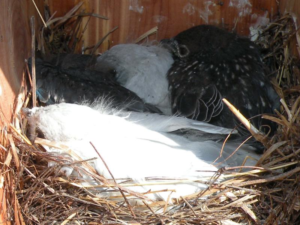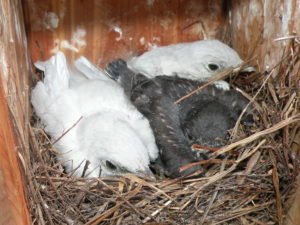In an entry posted on this blog this past June 4th, I wrote about two leucistic (white) bluebirds my husband found in a nestbox he monitors in Southern Berks County. You can see in those photos (just click on above link to view), there were four baby bluebirds with two of them being white. Albino birds have pink eyes. Leucistic birds have dark eyes as seen in both sets of photos.

Bluebird nest, May 2010
Two leucistic (white) bluebirds, two bluebirds
So, I ask you- what are the chances of this rare phenomenon to occur twice in the exact same place?
Check out these latest photos and see for yourself.
Three baby bluebirds this time – two of them, once again, are leucistic. The date (July 25th) on the Reading Eagle newspaper clearly shows this occurred this month. So I guess it’s safe to say lightning can strike twice in the same place!
Just what are the odds of this rare phenomenon? Well we’re going to find out.
Ed has been in contact with the North American Blue Bird Society (NABBS) and Sialas about this rare occurrence. To suggest that these people were thrilled about this phenomenon is putting it mildly. Dan Sparks (Indiana) from the NABBS is calling scientists, geneticists and doctors of Ornithology to find out the odds and to shed more light on this situation.
Now I admit I’m no expert and nor do I have the interest of birds as my husband does but I have to admit this finding has me very intrigued. To know scientists and others of their caliber want not only to document this finding but to possibly do a write-up in a journal is astounding. I now realize the magnitude of this extraordinary series of events.
Bet Zimmerman of Sialis sent the following information that correlates with leucistic birds.
“Both parents must have the recessive albino gene for their young to be albinos. Inbreeding in small populations increases the odds that both parents will have the recessive gene and therefore produce albino young.”
“Since each egg has its own set of genes, not all young in a nest will be albino or leucistic. Clutches with just one or two white bluebirds have been seen. One pair of bluebirds in Georgia had three nestings – in the first, one out of three fledglings were white; in the second three out of five were white, and in the third three out of five were white (Menaboni, 1947). (If a single recessive gene is responsible, the odds are 25% that the offspring of two parents with the recessive gene will have the mutation. Note that not all young in a nest always have the same parents, due to extra-pair mating and egg dumping.”
By the way, Bet wants to publish these photos you are viewing on Sialis’s website. Sialis is actually one of Ed’s favorite bluebird websites and he feels honored to have been asked.
1947- That is the last time consecutive bluebird nestings with leucistic birds had happened, according to Sialis. Amazing!!
Update on the leucistic birds: From the first brood, Ed has seen these two leucistic birds together being chased by an Eastern King bird. Yes, the first two have survived and are doing well. That is an amazing feat in itself.
The second brood fledged (left) yesterday (29th). Since there has been so much interest in this particular posting, Ed said he will update in the comments section about the continual sightings and the feedback he receives from the experts. (Pssst………I will post updates from the experts because of this exceptional attention this has received thus far.)
Ed wants to thank Jack Holcomb (WEEU) of Jack’s Backyard (radio program) and the Gerhart’s of Wild Birds Unlimited for their expertise and direction of this matter.
All I can say, this is one for the record books, without a doubt! Ed came upon an extraordinary find. What are the odds of finding four leucistic bluebirds in one season? Ed’s goal was to help repopulate the area with bluebirds and he has. But he has also come upon this amazing discovery that has bluebird enthusiasts buzzing! Congrats, Ed!
One final thought: Is a bluebird still a bluebird if it is white? Hmm.

